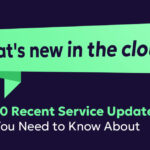
Going Multicloud? Think About These Five Things First

CEO and Co-founder
(This post was originally published on The New Stack)
We’re knocking on 2022, and Gartner has predicted that 75% of enterprises that use IaaS have already implemented a deliberate multicloud strategy by now. The benefits of multi-cloud are now clear to organizations across the board, from avoiding vendor lock-in, to better disaster preparedness, and even competitive pricing – which 58% call their top benefit of a multicloud strategy.
However, no two organizations are exactly alike – and despite all the potential benefits of going multi, what’s right for one business may not suit another. Here are five points to evaluate before you make the multicloud leap.
Making the Best of a Multi-Vendor Offering
- Redundancy: It’s not enough to say “we use multiple clouds so we’re covered in case of an outage.” You need to set up rules and policies in your incident response plans to enable one cloud to take over where another fails.
- Backups: Use your multicloud environment to enable best-practice backups, such as ensuring data is backed up in the right geographic location to meet compliance, or using one cloud provider as a backup for another.
- Cloud tools: Based on your research, which provider is best for your needs? For example, if your on-premise systems heavily depend on Windows OS, you might find some elements of Azure useful, while GCP is known for machine learning. Perhaps you can reduce costs by running certain workloads on AWS. You can even find niche cloud services for specific industries, such as Tresorit for healthcare, which can help with some of the regulatory hoops and hurdles.
Thinking Carefully About Security
It’s not true that multicloud is less secure, but it does take a different approach to security. Again, silos are not your friend here, so there’s no point securing each cloud with its own cloud native tools and considering your job done. The gaps and communications in between your cloud environments will be your weak spots, so make a plan for your whole environment as if you’re protecting a single perimeter.
This starts with defining all of your Identity and Access Management in a centralized way, rather than starting with your ‘main’ or first cloud and expanding from there. Think about user roles, least privilege and how data access and communications will be encrypted and monitored as well as human access. Don’t forget monitoring and maintenance – whatever you use for updates and patch management, make sure it has some context so that all upgrades are aligned with the workload, IaaS and any external or internal dependencies.
Keeping a Tight Rein on Your Costs
When done right, multicloud can save you money, but you’ll need a lot of oversight to make sure you’re making the most of the benefits. When you sign up to the cloud, there are a lot of buzzwords that sound really appealing, like elastic scaling, pay for what you use, agility and automation – but none of these happen on their own.
You’ll need to take advantage of automatic scaling and right sizing of instances and workloads, discounted pricing such as reserved instances or spot instances where they are relevant to the business, power scheduling where non-essential workloads are shut down at off-peak times, and the visibility to know what’s idle and needs to be removed altogether. Now multiply this by what works for each cloud provider. In short? If you haven’t established a cloud FinOps team yet, now is the tipping point you’ve been waiting for.
Ensuring You Have the Right People in Place
A lack of in-house skills can be a real stumbling block when it comes to a multi-cloud strategy. In fact, 85% of organizations report deficits in cloud infrastructure talent and expertise. Every area we’ve talked about so far, from security and compliance, to development and FinOps needs people who know what they are doing to steer the ship. We might sound like a broken record, but multiple clouds means multiplying the effort, with far more roles that will need to be filled.
If you’re not sure you can attract the right candidates, that doesn’t mean your multicloud strategy stops here. Consider retraining your existing staff (a great workplace perk), or leaning on managed services to handle the parts of your cloud expansion where you feel the least confident.
Working to Reduce Complexity with AI
In many cases, you might find that there is already a tool or a technology out there that can fill an important gap for your business, and help you to make more of a success of your multicloud strategy. On an infrastructure level, this might be as straightforward as building on microservices and containers to allow for portability across clouds and on-premise. Similarly, developers are trending towards serverless computing for the same reasons.
The next wave of solutions will go beyond infrastructure itself, and handle the growing challenges of monitoring and managing cloud sprawl for issues such as security and cost savings. Currently, just 11% of companies are happy with the visibility and monitoring they have of their cloud environment. To ensure that they aren’t completely overwhelmed, companies need help. This is more than finding an expert member of staff or two, this is about moving to a greater reliance on AI to support human cloud engineers. With that in place, enterprises can access real-time insights in the context of what matters (goodbye alert fatigue), and leverage AI-driven technology that can ingest data from multiple sources and make smart decisions on their behalf (hello coffee break).
Multicloud is all the rage – and for good reason. With a strong strategy (and the right tools), you can remove the fear of vendor lock-in and start benefiting from cost savings, flexibility, and reduced vulnerability.
Looking for a simple, intuitive, and effortless way to manage your cloud? Contact one of our cloud experts to give Zesty a try!
Related Articles
-
Cloud Updates – September 2024
October 16, 2024 -
 This is why modern finance professionals must understand Cloud FinOps
This is why modern finance professionals must understand Cloud FinOps
September 19, 2024 -
 Zesty Disk now optimizes AWS EBS costs across all major operating systems
Zesty Disk now optimizes AWS EBS costs across all major operating systems
August 28, 2024 -
10 CSPs cloud service updates – July
August 6, 2024 -
 Zesty introduces Insights: actionable recommendations for immediate cloud savings
Zesty introduces Insights: actionable recommendations for immediate cloud savings
July 24, 2024





